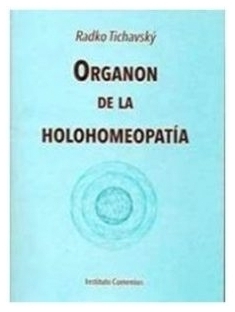Radko Tichavsky is now offering a one semester virtual course in Holohomeopathy (in English). You can learn how to define and analyze holons and how to repertorize the specific homeopathic treatment beyond just disease or pest names. You can find out more here: www.icomenius.edu.mx

NEW BOOK:
Organon de la Holohomeopatía
Six years in the making, it is the latest book by Radko Tichavsky, researcher on the application of homeopathy in agriculture. This Spanish language book covers homeopathic interventions in agriculture from the holistic view, allowing greater certainty in repertorizations. It addresses a novel concept of metabolic similarity, not only among plants, but also among different species of the animal and plant kingdom. It studies the formation and dynamics of attractors, areas of greater vitality within the holons and coexistence units of different living organisms. Holohomeopathy is a fascinating contribution to the application of homeopathy to plants. It allows one to discover a universe of surprising relations in vital dynamism. It puts into the hands of the agricultural producer a valuable tool for the successful handling of pests and diseases in crops of any size. For ordering or information: [email protected]
Gratitude
Thanks to Radko Tichavsky, my apple tree has recovered! It’s miraculous. It had all dried leaves just very few green ones from salty wind and bugs. It’s got lots of new green leaves and looks amazing!! Big thanks to Radko Tichavsky, I’m so grateful!
Marianne Thatcher
Dear Radko,
The Spotted Lanternfly turned up in our neighborhood here in Lancaster, Pennsylvania (U.S.) Zipcode 17540. We put sticky tape on the trunk of our Maple tree and it caught some of them, but we see many others higher up in the tree. There seem to more each day. Are there any other non-toxic methods of controlling them?

Thank you
Brian Olsen
Radko Tichavsky:
Dear Brian,
Lycorma delicatula is an invasive exotic pest, originating in China. Due to its characteristics it has few natural enemies in America. It attacks mainly Ailanthus altísima ((tree of heaven) Cedrela fisillis (Spanish cedar) Juglands Madshurica (Manchutian walnut), Melia azedarach (Chinaberry) and some plants of the family Rutaceae Simaroubacea, besides several types of Vitis sp. (Grape vine, Amur grape). It is currently distributed in Pennsylvania, New York, Virginia, Delaware and New Jersey, and is likely to expand further in the future.
As with all exotic pests, these in principle form a curve with rapid ascent as to new territories. This is due to their misadaptation and lack of metabolic connections in the holon. But once they are detected as possible prey by natural enemies this curve begins to descend and with it also decreases its pathogenesity.
The adult insect uses carvone and limonene as hormonal attractors. Carvone you can get in the essential oil of Carum carvi (a common spice in culinary use) and limonene is in the essential oil of lemon or in the essential oil of Vitex agnus castus. You can boil in half a litre of sunflower oil three spoonfuls of Carum carvi seeds and the peel of one lemon for approximately 5 minutes. Once the oil has cooled, place it in a trap (for example made from a PET bottle) in the middle of the tree trunk and fix it with a wire. Adult insects will approach and drown in the oil. Either of the two remedies (or both together) serve as strong attractors.
Cantharis 6 CH, containing cantharidine, is commonly used in human homeopathic medicine and the insect used it as a means of defense. Lycorma delicatula has sophisticated defense mechanisms, for example it consumes parts of the Melia azedarach a toxic tree and strong insecticide to acquire toxicity against organisms that could depredate it. Cantharis 12 CH sprayed around the trunk will gradually attract some local predators of the eggs of the Lycorma delicatula, but as indicated, this will be a slow process and will depend on the biodiversity of insects and fragmentation in each holon.
Dear Radko,
Thank you for your reply to my question regarding Horse Chestnut trees and disease in the UK in the September issue of Homeopathy for Everyone.
Thank you for such a fascinating and informative answer. I’ve had to re-read it several times! Following on from what you said could I ask you the following questions in regards to putting into action some of your suggestions.
You suggested the remedies – Acidium salycium, Kali phosphoricum and Silicea phosphorica in 12c. Would you give these in succession -ie a week apart or what would you advise for application and how often?
You also mentioned Vitamin B1 complex. What dosage would you recommend and again how often? Would this be to the root areas too? I was fascinated by the concept of Polyploidia induction. Could you please provide some guidance on application of Colchicum autumnale? Could this work for all trees, not just Horse Chestnut?
Thank you
Best regards
James
Radko Tichavsky:
Dear James,
Acidum salycicum, Kalium phosphoricum, Silicea phosphorica in potency 12 CH can be applied alternately once every two weeks for six months. Vitamin B1 complex supplementation in ponderal doses, 300 mg dissolved in 20:l of water is sprayed over the soil around the trunk once per month for six months. As far as Colchicum is concerned, as an inducer of polyploidy in many plants, low potencies between about 3 CH are used and applied on the top of the tree (not in the radical system because it is toxic to this). Experiments with Colchicum have been done on many other plants with similar results, and it is interesting to know that Colchicum not only polypoidizes plants but also endophytes (bacteria and fungi that live in plant sap). In addition, there is a large list of other plants that can polyploidize different species of plants, for example Taxus baccata, Sansevieria trifasciata, Larrea tridentata among others.
Dear Dr.,
This summer my cucumber vines started very healthy but soon these yellow beetles with black spots came on them and the vine started wilting and dying.
Also this summer there were lots of Japanese beetles eating leaves of big trees and other plants. What to do for next summer? We are in Toronto Canada and for the first time, the weather has been mild.
Thank you
Gudi [email protected]
Radko Tichavsky:
Dear Gudi,
In this case, the Diabrotica undecimpunctata and Popillia japonica can be eliminated by applying entomopathogenic fungi such as Bauveria bassiana or with the application of Bacillus thuringensis for example. However, the appearance of Diabrotica spp. is an important bioindicator of imbalances in the soil that must be resolved first. The Diabrotica sp. together with some types of ants like Crematogaster sp. for example indicate a soil with bad structure. On the other hand the Popillia japonica frequently bioindicate the excessive application of fertilizers based on animal excrement or the high density of the herbivores and imbalances in the proportion of nitrogen and carbon in the holon. Excess nitrogen is balanced by the presence of sucking and chewing insects who convert excess nitrogen with the help of bacterias and other microorganisms into carbon.
Carbo vegetabilis 6 CH alternated with Acidum nitricum 30 CH help to re-establish the balance. The fertilization of crops based on compost of vegetable origin, the non-use of artificial fertilizers and avoiding the application of animal excrement or composts made from this excrement are some of the recommended practices. And most importantly, maintain a vigorous and biodiverse bacterial-fungal community in the soil using mulching of a large biodiversity of plants as an obligatory part of all agricultural crops.
Dear Radko,
I would greatly value your thoughts on the Chalara Ash dieback that is so prevalent at the moment. It is taking hold in the South of England and seems to be especially severe in the younger trees. I’m aware it is caused by the air borne fungus Hymenoscyphus.
Thank you
James
Radko Tichavsky:
Dear James,
Inside each tree lives a whole community of bacteria and fungi. Most of them are beneficial and help the tree be healthy and only some of them, as Botrytis cinerea, Alternaria alternata, Phomosis oblonga, Pseudomonas sp. or Hymenoscyphus fraxinus for example are pathogens. In a healthy adult tree there are communities of approximately 60 different mushrooms, depending on the place, vital conditions and age of the tree. This large community of endogenous endophyte fungus includes both beneficial and patogenic mushrooms living together in balance.
Some fungi, especially Phomosis oblonga or Ophiostoma sp. make trees sensitive to the pathogenic fungus Hymenoscyphus fraxinus, causing Chalara ash dieback syndrome.
Climatic conditions, such as high temperature, humidity and thunderstorms activate the proliferation of fast-growing fungi in the tree, important for balancing and counteracting the proliferation of Hymenoscyphus fraxinus. But in winter, when low temperatures and fast-growing fungi inhibit their development, young trees containing a poorly biodiverse fungal community are especially exposed to slow-growing pathogenic fungi that affect xylema, such as the Hymenoscyphus fraxinus. The trees in different stages of their life choose between different vital strategies, presenting two main lines of action related to the fight against fungi: one typical for adult trees, is based on increasing the biodiversity of fungi and forming a community in balance, and the other, frequent in young trees, is based on small production of phenolic substances that inhibit fungi in general. This strategy is visibly unsuccessful and facilitates the attack of Hymenoscyphus fraxinus on young Fraxinus trees.
The metabolic pathway to elaborate phenols, defense substances in young ash trees, requires shikimic acid as precursor. We have then have two strategies to combat the pathogenic fungus H. Fraxinus: in adult trees we apply Ganoderma applanatum or Ganoderma lucidum at the potency 6 CH, mainly as promoters of movement of the sap in the tree, and integrators of biodiverse communities of fungi in the tree. In young trees the main remedy is Ricinus communis 6 CH, which should be applied during the winter once or twice a month, depending on the degree the trees are affected. Ricinus communis should not be applied to young trees during the summer because it would inhibit the formation of fast-growing fungal communities, important for gradually building defenses against slow-growing fungi such as Hymenoscyphus fraxinus and a balanced endofungal community when the tree is adult.







How can I change my salt land to a fertile land through homoeopathy. out of 1 acre 32 cents is content more of salt….this 1 acre i am doing banana forming….
Dear Sivagnanam,
You could try molybdenum metallicum, D30, once 4 pills/10 l of water, mix this water with 100 l. Pour the 100 l on your land.
Greetings from Germany
Sabine Krümmer
Very interested in following up on your answer to Ash Dieback and wondering if you might be able to put me in touch with “James” (or if you’re out there James, please make contact!)
Ash dieback is now across the whole England (am in Cornwall, UK) and mass tree deaths. Really hope one of the suggestions has shown some success, with any tips on how and when they are the most beneficial.